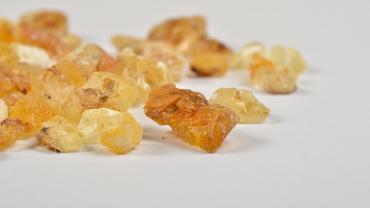
The resin of Boswellia serrata, commonly known as frankincense, has been used for centuries both culturally and medicinally, stemming from North Africa, West Asia, and the dry mountainous regions of South Asia. Historically, Boswellia has been used to support health in the presence of certain chronic inflammatory diseases. Recent scientific research also suggests that it shows promise in ailments such as bronchial asthma, bursitis, rheumatoid arthritis, Crohn’s disease, and other inflammatory conditions. However, Boswellia is currently known best for its support with osteoarthritis.
A systematic review and meta-analysis was published in 2020 assessing the effectiveness and safety of Boswellia when used for osteoarthritis (OA). This study was the most recent and most thorough of its kind regarding Boswellia, which included randomized control trials totaling 545 participants. Overall assessments for pain, stiffness, and function were administered to each patient using validated indices, such as the Lequesne index, Visual Analogue Scale pain scores, and the Western Ontario and McMaster Universities Osteoarthritis Index (WOMAC). Boswellia and its extracts were shown to relieve pain as compared to a placebo. Stiffness and function were assessed at weeks 4, 8, and 12, which showed improvement in the treatment arm. There was no statistical difference between treatment arms regarding safety for this study, demonstrating that Boswellia appears to be as safe as a placebo. Animal studies have also shown that Boswellia and its extract are unlikely to show any toxic manifestations.
A constituent of Boswellia, acetyl-11-keto-β-boswellic acid (AKBA) was recently studied for its potential to protect against bone loss during osteoporosis. AKBA is believed to inhibit tumor necrosis factor-α expression, which has a downstream effect of reducing nuclear factor kappa B receptor activation, thereby inhibiting osteoclastogenesis. In this animal study, the treatment arm with AKBA showed significantly reduced bone loss measured with both biological and physical parameters, in addition to histopathologic restoration of bone architecture. It was also noted that AKBA did not show biological, hematological, or histopathological toxic effects.
Another systematic review and meta-analysis assessed Boswellia and curcuminoids, constituents found in turmeric, in relation to knee osteoarthritis. The results suggested that formulations with both Boswellia and curcuminoids were significantly more effective than a placebo at symptom relief for knee osteoarthritis. Safety risks were not significant. This study also indicated that future research could be warranted regarding the possible synergistic effects between curcuminoids and Boswellia.
Supporting musculoskeletal health can be clinically challenging, as many choices have concerning safety profiles or may not be efficacious. Boswellia serrata and its extracts have been shown to support bone health in relation to osteoarthritis and osteoporosis with promising safety data.
By Colleen Ambrose, ND, MAT